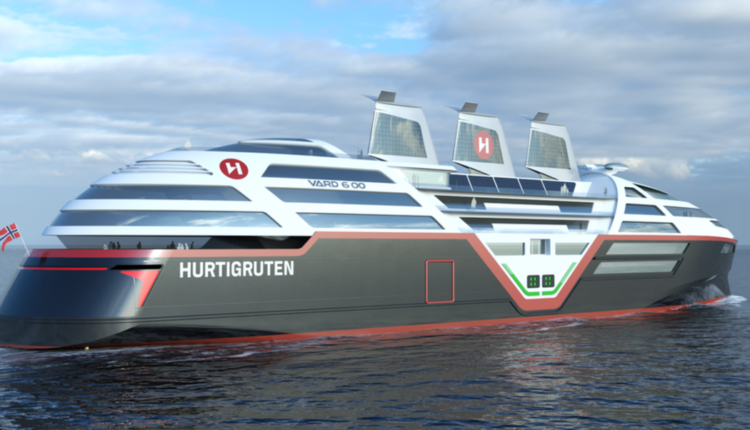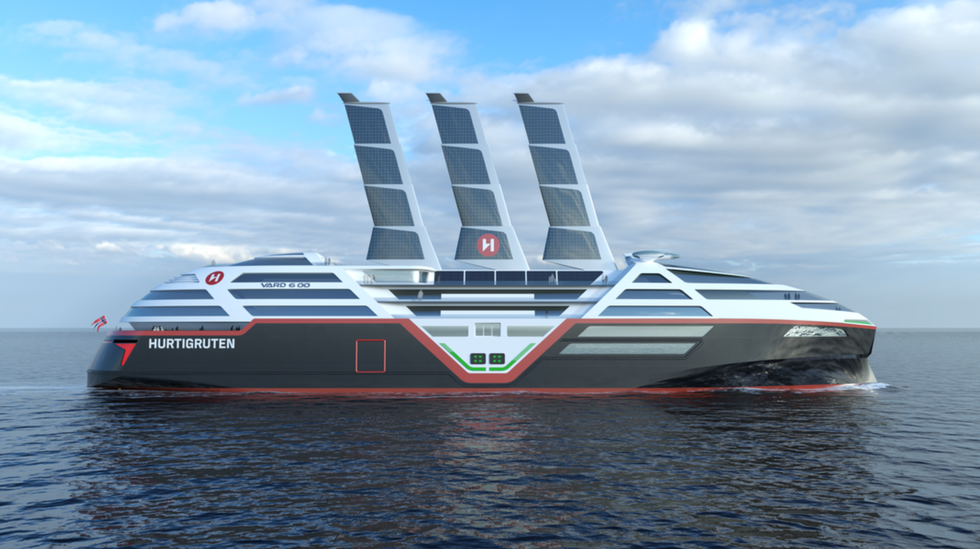- Cruise ships are notorious greenhouse gas emitters, producing high levels of sulphur oxides, nitrogen oxides, and carbon dioxide.
- Hurtigruten, a Norwegian transport and cruise company, revealed an ambitious design for a zero-emissions cruise liner with retractable “wing sails,” 16,000 square feet of solar panels, and 60 megawatt batteries.
- The company hopes to have this new species of cruise liner traveling the Norwegian coast by 2030.
Cruise ships have a dirty secret: they pollute…a lot. According to a 2019 report by a sustainable transport group Transport & Environment, the world’s largest cruise operator, Carnival, emitted 10 times as much sulfur oxide (SOx) in 2017 than all of Europe’s cars combined. The report was nothing new for environmentalists, who’ve been highlighting cruise lines’ abysmal environmental records since at least the 1990s.
With thousands of passengers and crew onboard, cruise ships are essentially floating cities that require immense amounts of power, usually generated from diesel-electric engines. Those engines require a lot of fuel—250 tons a day, according to one estimate—which is more gas than you’ll ever use in your car in your entire lifetime. Similar to the airline industry, the cruise industry is facing immense engineering challenges to overcome its dirty dependencies. Can cruise ships ever kick their fossil fuel habit?
Well, one Norwegian cruise company is going to give it a try.
More From Men’s Health

Last week, Hurtigruten revealed the design of its first zero-emissions cruise ship as part of the research project Sea Zero. The design uses retractable, solar-panel-covered sails, as well as 60-megawatt batteries to power a 500-person (plus crew) vessel from port to port. Once docked, the ship can then recharge its batteries using Norway’s 98 percent renewable electricity grid. With a 300-to-350 nautical mile range, a ship would need to recharge 7 or 8 times on a standard 11-day cruise.
But the most striking features of the zero-emissions ship are the 164-foot-tall retractable “wing sails.” These sails rotate to leverage wind power, and are bedecked with 16,000 square feet of solar panels. Although solar can be unreliable (to say the least) in Norwegian winters, in the summer, the ship could receive 24/7 sunlight (at least, in its more northern routesm near the arctic).
The ship’s wing sails are also designed to be retractable, so that the cruise liner can easily pass under necessary bridges. Although visual striking, wing sails as a concept aren’t new—other eco-conscious shipping companies have proposed wind-powered cargo carriers using similar technology. As for Hurtigruten, the company hopes to finalize the design by 2026, start building in 2027, and hopefully set sail by 2030.
“The reason why we are so focused on this is that a lot of our operation has historically been around the poles, both in the south and in north,” Hurtigruten CEO Daniel Skjeldam said in an interview in October of 2022. “And that’s where you see the effect of climate change the earliest. I mean personally, seeing the melting glaciers, seeing the changing weather conditions in the high north. It is scary.”
Hurtigruten, has been plying Norway’s coastline for 130 years, and is already considered one of the most sustainable cruise companies in the world. They’ve outfitted their current fleet with hybrid technology to cut CO2 and nitrogen oxide (NOx) emissions, while banning the use of toxic heavy fuel oil. But Hurtigruten, which means “the fastest route,” is a small company, and its 500-person boats are mere guppies compared to the behemoth floating cities that traverse the Mediterranean and Caribbean.
If Hurtigruten can deliver on its zero-emission promise, it’ll definitely make waves—but will they be big enough for the world’s largest cruise companies to feel its wake?
Darren lives in Portland, has a cat, and writes/edits about sci-fi and how our world works. You can find his previous stuff at Gizmodo and Paste if you look hard enough.



Comments are closed.